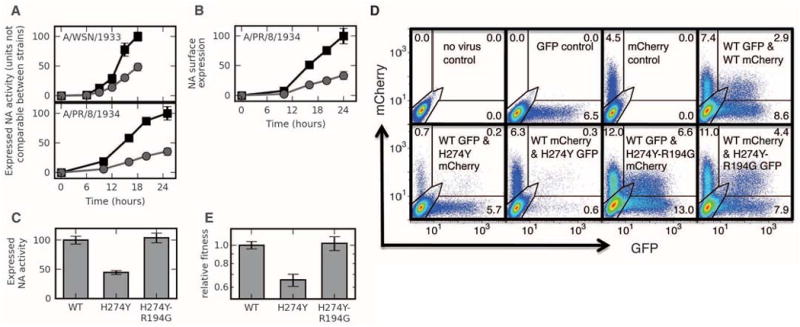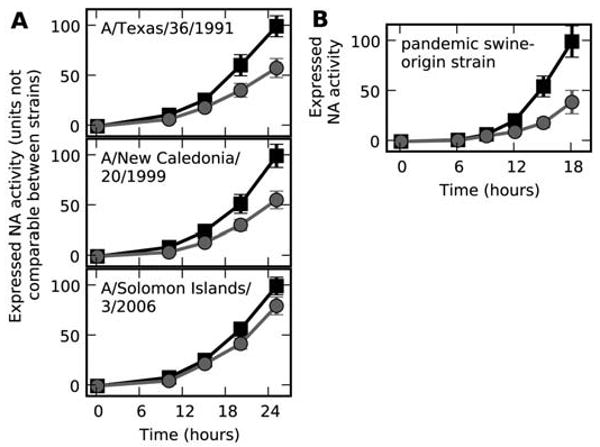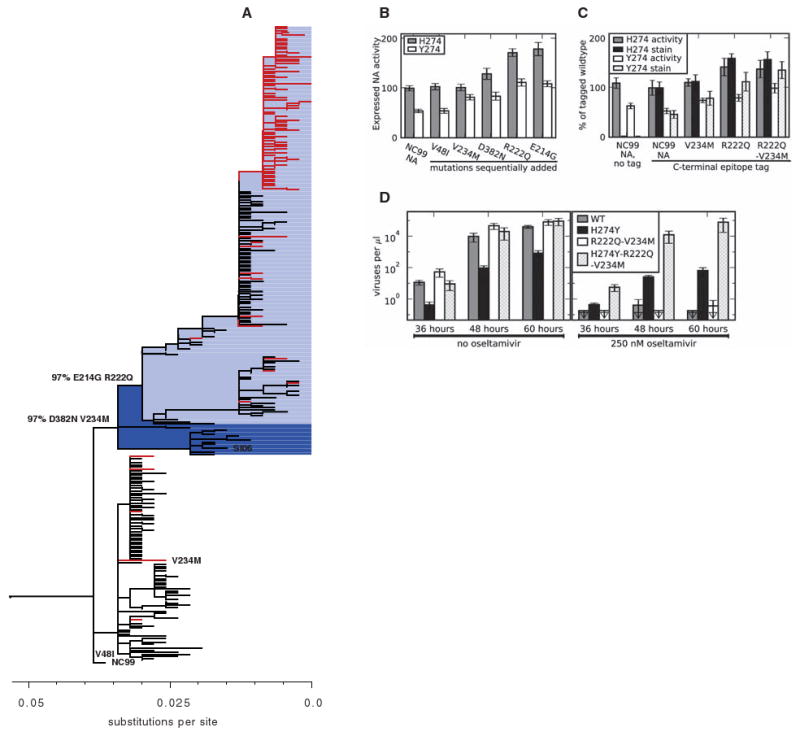Abstract
The His274→Tyr274 (H274Y) mutation confers oseltamivir resistance on N1 influenza neuraminidase but had long been thought to compromise viral fitness. However, beginning in 2007–2008, viruses containing H274Y rapidly became predominant among human seasonal H1N1 isolates. We show that H274Y decreases the amount of neuraminidase that reaches the cell surface and that this defect can be counteracted by secondary mutations that also restore viral fitness. Two such mutations occurred in seasonal H1N1 shortly before the widespread appearance of H274Y. The evolution of oseltamivir resistance was therefore enabled by “permissive” mutations that allowed the virus to tolerate subsequent occurrences of H274Y. An understanding of this process may provide a basis for predicting the evolution of oseltamivir resistance in other influenza strains.
Influenza A is a respiratory virus that causes annual epidemics and occasional pandemics, of which the worst on record killed in excess of 20 million people worldwide (1). One of the main defenses against influenza is the antiviral drug oseltamivir (Tamiflu, F. Hoffmann-La Roche, Incorporated) (2), and over 200 million doses have been stockpiled worldwide (3). Oseltamivir binds in the active site of the neuraminidase (NA) enzyme expressed on the virion surface, preventing it from cleaving sialic acid moieties that can be bound by the viral hemagglutinin protein (2). This lack of NA activity inhibits the release of newly formed virions from infected cells (4), as well as causing viral aggregation (4), reducing infectivity (5, 6), and limiting the ability of viruses to penetrate mucus found in the airways (6).
During clinical testing of oseltamivir, a small fraction of human participants who were infected with the seasonal human H1N1 influenza strain A/Texas/36/1991 (TX91) and then treated with oseltamivir eventually shed resistant viruses (7). These viruses carried a mutation of histidine to tyrosine at NA residue 274 (H274Y), which is found near but not directly in the substrate-binding pocket (8). This mutation causes subtle structural alterations that weaken oseltamivir binding (8, 9). However, TX91 viruses with H274Y were attenuated in tissue culture, mice, and ferrets (10). H274Y also impaired the growth of the H1N1 lab strain A/WSN/33 (WSN) in tissue culture (11) and the infectivity of the seasonal H1N1 strain A/New Caledonia/20/1999 (NC99) in ferrets (12). These studies led to the conclusion that “[v]irus carrying a H274Y mutation is unlikely to be of clinical consequence (10).”
This conclusion held sway from the introduction of oseltamivir as a drug in 1999 until the 2007–2008 influenza season, when oseltamivir-resistant H274Y seasonal H1N1 viruses appeared worldwide (13). Within a year, H274Y was present in most seasonal H1N1 (13). These viruses showed no obvious attenuation relative to earlier viruses carrying tyrosine at position 274 (14).
We hypothesized that the evolution of oseltamivir resistance was enabled by permissive mutations that alleviated the deleterious effects of subsequent occurrences of H274Y. Earlier studies have failed to find large effects of H274Y on substrate affinity or catalytic rate in otherwise isogenic NAs (9–11). We therefore further hypothesized that these permissive mutations buffered previously unobserved deficiencies in NA folding or stability caused by H274Y. This hypothesis was motivated by the observation that functionally adaptive mutations often come at a cost to protein stability or folding and that mutations that bolster these properties can therefore promote evolvability (15).
Preliminary experiments uncovered no obvious differences in the stabilities of wild-type and H274Y NAs to irreversible thermal denaturation (fig. S1), so we examined whether H274Y hampered the efficiency with which folded NA reached the cell surface. Plasmids encoding wild-type or H274Y NA were transfected into 293T cells, and the total NA activity expressed on the cell surface was measured by using a fluorogenic substrate (16). Cells transfected with wild-type NA expressed at least twofold more total surface activity than those transfected with H274Y, both for NAs from WSN and from another H1N1 lab strain, A/PR/8/34 (PR8) (Fig. 1A). Previous studies found little effect of H274Y on the catalytic activity per unit enzyme (9–11), suggesting that the differences are due to fewer NAs at the cell surface. To test this, we used a monoclonal antibody to quantify the amount of PR8 NA on the surface of transfected cells (Fig. 1B). Surface expression closely corresponded to total surface activity, confirming that H274Y decreases the amount of NA that is inserted into the membrane.
Fig. 1.

H274Y decreases NA surface expression and viral fitness for H1N1 lab strains. (A) Plasmids encoding wild-type (WT, black squares) or H274Y (gray circles) NAs were transfected into 293T cells. Cells were assayed for total surface NA activity in a nonlysing buffer. (B) The same cells were assayed by flow cytometry for mean surface NA expression using a monoclonal antibody against the PR8 tetramer. (C) Surface activity of WT, H274Y, or H274Y-R194G WSN NA at 18 hours. All four graphs show mean ± SEM for at least three independent transfections. (D) An estimated 50 infectious particles of each color of WSN-PB1flank-eGFP and/or mCherry carrying the indicated NA mutations were infected into 2.5 × 105 A549-CMV-PB1 cells. After 46 to 50 hours, the cells were analyzed by flow cytometry to quantify virus growth. Numbers give percentages of cells in each gate; one representative plot is shown for each virus pair. (E) Relative fitness (ratio of Malthusian growth parameters) with respect to WT calculated from at least eight replicates. Shown are geometric means and 95% confidence intervals.
An evolutionarily important feature of mutations that interfere with protein folding is that they can frequently be compensated for by other mutations at sites distant in the three-dimensional structure (17, 18). We used a computational method (19) to predict that Arg194→Gly194 (R194G), which occurs over 20 Å from H274Y in the folded structure (fig. S2), might have this compensatory effect on WSN NA. Introducing R194G into H274Y WSN NA restored the total surface-expressed activity to about wild-type levels (Fig. 1C).
To examine whether a mutation that restored NA surface expression would also restore viral fitness, we created WSN viruses possessing PB1 segments in which most of the coding sequence was replaced by a gene encoding either an enhanced green or a red fluorescent protein (eGFP or mCherry) (fig. S3). Because these segments retained the noncoding and 80 terminal coding nucleotides, they were packaged efficiently and stably into virions (20, 21) (fig. S3). These PB1flank-eGFP/mCherry viruses grew to high titers in cells constitutively expressing the PB1 protein. We created variants of both colors carrying wild-type, H274Y, or H274Y-R194G NAs and performed viral growth assays by adding about 50 infectious particles of each color to 2.5 × 105 A549 human lung carcinoma cells that expressed PB1 protein. After 46 to 50 hours, flow cytometry was used to quantify the cells infected by each color virus (Fig. 1D). WSN viruses with H274Y were strongly attenuated relative to wild type (Fig. 1E), in agreement with earlier work (11). However, H274Y virus also carrying R194G exhibited fitness indistinguishable from that of the wild type (Fig. 1E).
The foregoing results indicate that the defect caused by H274Y can be corrected by secondary mutations. To determine whether this actually occurred in human influenza, we examined NAs from seasonal H1N1. Introducing H274Y into TX91 and NC99 NAs caused an ∼twofold decrease in total surface expressed activity (Fig. 2A); earlier studies have shown that H274Y attenuates these strains in ferrets (10, 12). But H274Y caused a much smaller decrease in the more recent A/Solomon Islands/3/2006 (SI06) strain (Fig. 2A). We built a phylogenetic tree incorporating NC99 and all seasonal H1N1 NAs from 2006 or later (Fig. 3A) and traced along this tree from NC99 toward the large group of H274Y viruses, sequentially adding the first five reconstructed mutations in the order which maximum likelihood suggested that they occurred. Two of the reconstructed mutations had important effects on total surface-expressed NA activity (Fig. 3B). The first, Val234→Met234 (V234M) (which is found in SI06), decreased the magnitude of the defect caused by H274Y. The second, Arg222→Gln222 (R222Q), increased total surface-expressed activity for NAs both with and without H274Y. Both of these mutations were retained in all members of the large group of H274Y sequences (Fig. 3A). Neither mutation is in close contact with H274 in the folded NA structure (fig. S2).
Fig. 2.

Total surface-expressed activity for WT (black squares) and H274Y (gray circles) NAs from (A) three seasonal human H1N1 strains and (B) the pandemic swine-origin A/California/4/2009 (H1N1) strain. All graphs show mean ± SEM for at least three replicates.
Fig. 3.

Identification of mutations that buffer defects in NA surface expression and viral fitness caused by H274Y in seasonal human H1N1. (A) Maximum-likelihood phylogenetic tree showing NC99 and all seasonal H1N1 strains from 2006 or later. Based on a maximum-likelihood reconstruction, branches with H274Y are colored red, whereas those without are colored black. Indicated are the first five mutations on the path from NC99 to the large group of H274Y viruses. Bootstrap percentages are shown for key nodes. Branches with V234M are shaded dark blue, and those with both V234M and R222Q are shaded light blue. One of the isolated H274Y sequences contained an independent appearance of V234M as indicated. The NC99 and SI06 sequences are labeled. (B) Surface-expressed activity at 20 hours for NC99 NAs with sequential addition of the five reconstructed mutations, both with and without H274Y. (C) Surface-expressed activity and mean staining intensity at 20 hours for NC99 NAs containing a C-terminal epitope tag. (D) An estimated 50 infectious particles of PB1flank-eGFP with the indicated NC99 NAs and the remaining genes from TX91 were infected into 2.5 × 105 MDCK-SIAT1-CMV-PB1 cells, and the viral titer in the supernatent was determined at the indicated times. All graphs show mean ± SEM for at least three replicates.
To confirm that V234M and R222Q increase the amount of NA that reaches the cell surface, we added a C-terminal epitope tag. This tag was readily stained by fluorescent antibodies and did not substantially interfere with NA folding or function, because it caused at most a slight (<10%) decrease in total surface-expressed activity (Fig. 3C). Both V234M and R222Q increased the amount of NA that reached the cell surface; the activity per enzyme was unaffected by V234M and slightly decreased by R222Q (Fig. 3C). The NC99 NA carrying R222Q and V234M in addition to H274Y expressed a total surface activity roughly equivalent to that of wild type.
We next constructed PB1flank-eGFP viruses carrying NC99 NAs with the relevant mutations. The non-NA segments for these viruses were derived from the closely related (>98% protein identity) TX91 strain. We engineered a cell line (MDCK-SIAT1) that expresses high levels of the sialic acid linkage preferred by human influenza (22) to also constitutively express PB1 protein. We infected 2.5 × 105 cells with an estimated 50 infectious particles and monitored viral growth. The H274Y virus was strongly attenuated, growing to ∼100-fold lower titers than wild type (Fig. 3D). However, virus carrying H274Y in conjunction with R222Q and V234M grew to levels comparable to that of wild type, as did virus carrying just R222Q and V234M (Fig. 3D). In the presence of 250 nM oseltamivir, only viruses carrying H274Y grew to substantial titers, with the H274Y-R222Q-V234M triple mutant growing to over 100-fold higher titers than virus with H274Y alone (Fig. 3D). Therefore, by accumulating the permissive V234M and R222Q mutations and then acquiring H274Y, NC99 virus can become resistant to oseltamivir while maintaining high levels of fitness in the absence of drug.
It is interesting to speculate about what drove the spread of these mutations in seasonal H1N1. The permissive mutations could be the result of stochastic drift, genetic hitchhiking (23), or selection for antigenic change or tuning of the NA/hemagglutinin balance (24). Once the permissive mutations were in place, H274Y could have been the product of any of these same forces or of direct selection for oseltamivir resistance. The fact that initial geographic prevalence of H274Y was not correlated with oseltamivir usage is generally viewed as evidence against direct selection for resistance (25), although the lack of persistent spatial structure in human influenza (26, 27) makes it difficult to ascribe selection pressures to specific geographic locations.
Regardless of the forces that eventually drove its spread, our results show that H274Yattenuates seasonal H1N1 unless there are permissive secondary mutations that maintain adequate surface NA expression. These mutations likely buffer defects in NA folding or transport that are caused by H274Y. The reduced fitness of H274Y viruses in the absence of such permissive mutations could be caused by insufficient NA to balance the receptor binding of hemagglutinin (24) or to stimulate proper virion assembly (28).
The evolution of H274Y in seasonal H1N1 adds to a growing collection of examples of the importance of permissive mutations in molecular evolution. These examples include the evolution of bacterial antibiotic resistance (29, 30), the escape of HIV from cytotoxic T lymphocytes (31), and the acquisition of new ligand specificity in vertebrate steroid receptors (32). An appealing aspect of our findings is that, in addition to elucidating the historic role of permissive mutations, they may also provide a basis for making informed predictions. The pandemic swine-origin 2009 A(H1N1) viruses that recently swept the globe remain mostly oseltamivir-sensitive, but scattered H274Y isolates have emerged (33). It remains unclear whether these isolates are less-fit evolutionary dead ends or harbingers of a resistance mutation that will soon spread worldwide. Introducing H274Y into the swine-origin A/California/4/2009 NA causes a large drop in total surface-expressed activity (Fig. 2B). We therefore suggest that, unless these swine-origin viruses already express substantial excess NA, the long-term evolutionary potential of H274Y isolates might depend on secondary mutations that rescue NA surface expression.
Supplementary Material
Acknowledgments
J.D.B. was supported by a Beckman Institute Postdoctoral Fellowship and the Irvington Institute Fellowship Program of the Cancer Research Institute. L.I.G. was supported by a Summer Undergraduate Research Fellowship from the California Institute of Technology. Oseltamivir carboxylate was kindly provided by Roche.
Footnotes
Supporting Online Material: www.sciencemag.org/cgi/content/full/328/5983/1272/DC1
Materials and Methods
Figs. S1 to S3
Tables S1 and S2
References and Notes
- 1.Johnson NP, Mueller J. Bull Hist Med. 2002;76:105. doi: 10.1353/bhm.2002.0022. [DOI] [PubMed] [Google Scholar]
- 2.Moscona A. N Engl J Med. 2005;353:1363. doi: 10.1056/NEJMra050740. [DOI] [PubMed] [Google Scholar]
- 3.Wan Po AL, Farndon P, Palmer N. Emerg Infect Dis. 2009;15:1686. doi: 10.3201/eid1510.090844. [DOI] [PMC free article] [PubMed] [Google Scholar]
- 4.Liu C, Eichelberger MC, Compans RW, Air GM. J Virol. 1995;69:1099. doi: 10.1128/jvi.69.2.1099-1106.1995. [DOI] [PMC free article] [PubMed] [Google Scholar]
- 5.Suzuki T, et al. J Virol. 2005;79:11705. doi: 10.1128/JVI.79.18.11705-11715.2005. [DOI] [PMC free article] [PubMed] [Google Scholar]
- 6.Matrosovich MN, Matrosovich TY, Gray T, Roberts NA, Klenk HD. J Virol. 2004;78:12665. doi: 10.1128/JVI.78.22.12665-12667.2004. [DOI] [PMC free article] [PubMed] [Google Scholar]
- 7.Gubareva LV, Kaiser L, Matrosovich MN, Soo-Hoo Y, Hayden FG. J Infect Dis. 2001;183:523. doi: 10.1086/318537. [DOI] [PubMed] [Google Scholar]
- 8.Russell RJ, et al. Nature. 2006;443:45. doi: 10.1038/nature05114. [DOI] [PubMed] [Google Scholar]
- 9.Collins PJ, et al. Nature. 2008;453:1258. doi: 10.1038/nature06956. [DOI] [PubMed] [Google Scholar]
- 10.Ives JA, et al. Antiviral Res. 2002;55:307. doi: 10.1016/s0166-3542(02)00053-0. [DOI] [PubMed] [Google Scholar]
- 11.Abed Y, Goyette N, Boivin G. Antivir Ther. 2004;9:577. [PubMed] [Google Scholar]
- 12.Herlocher ML, et al. J Infect Dis. 2004;190:1627. doi: 10.1086/424572. [DOI] [PubMed] [Google Scholar]
- 13.Moscona A. N Engl J Med. 2009;360:953. doi: 10.1056/NEJMp0900648. [DOI] [PubMed] [Google Scholar]
- 14.Rameix-Welti MA, et al. PLoS Pathog. 2008;4:e1000103. doi: 10.1371/journal.ppat.1000103. [DOI] [PMC free article] [PubMed] [Google Scholar]
- 15.Bloom JD, Labthavikul ST, Otey CR, Arnold FH. Proc Natl Acad Sci USA. 2006;103:5869. doi: 10.1073/pnas.0510098103. [DOI] [PMC free article] [PubMed] [Google Scholar]
- 16.Materials and methods are available as supporting material on Science Online.
- 17.Poteete AR, Rennell D, Bouvier SE, Hardy LW. Protein Sci. 1997;6:2418. doi: 10.1002/pro.5560061115. [DOI] [PMC free article] [PubMed] [Google Scholar]
- 18.Mitraki A, Fane B, Haase-Pettingell C, Sturtevant J, King J. Science. 1991;253:54. doi: 10.1126/science.1648264. [DOI] [PubMed] [Google Scholar]
- 19.Bloom JD, Glassman MJ. PLOS Comput Biol. 2009;5:e1000349. doi: 10.1371/journal.pcbi.1000349. [DOI] [PMC free article] [PubMed] [Google Scholar]
- 20.Muramoto Y, et al. J Virol. 2006;80:2318. doi: 10.1128/JVI.80.5.2318-2325.2006. [DOI] [PMC free article] [PubMed] [Google Scholar]
- 21.Liang Y, Hong Y, Parslow TG. J Virol. 2005;79:10348. doi: 10.1128/JVI.79.16.10348-10355.2005. [DOI] [PMC free article] [PubMed] [Google Scholar]
- 22.Matrosovich M, Matrosovich T, Carr J, Roberts NA, Klenk HD. J Virol. 2003;77:8418. doi: 10.1128/JVI.77.15.8418-8425.2003. [DOI] [PMC free article] [PubMed] [Google Scholar]
- 23.Simonsen L, et al. Mol Biol Evol. 2007;24:1811. doi: 10.1093/molbev/msm103. [DOI] [PubMed] [Google Scholar]
- 24.Wagner R, Matrosovich M, Klenk HD. Rev Med Virol. 2002;12:159. doi: 10.1002/rmv.352. [DOI] [PubMed] [Google Scholar]
- 25.Kramarz P, Monnet D, Nicoll A, Yilmaz C, Ciancio B. Euro Surveill. 2009;14:19112. doi: 10.2807/ese.14.05.19112-en. [DOI] [PubMed] [Google Scholar]
- 26.Nelson MI, et al. PLoS Pathog. 2008;4:e1000133. doi: 10.1371/journal.ppat.1000133. [DOI] [PMC free article] [PubMed] [Google Scholar]
- 27.Rambaut A, et al. Nature. 2008;453:615. doi: 10.1038/nature06945. [DOI] [PMC free article] [PubMed] [Google Scholar]
- 28.Nayak DP, Balogun RA, Yamada H, Zhou ZH, Barman S. Virus Res. 2009;143:147. doi: 10.1016/j.virusres.2009.05.010. [DOI] [PMC free article] [PubMed] [Google Scholar]
- 29.Wang X, Minasov G, Shoichet BK. J Mol Biol. 2002;320:85. doi: 10.1016/S0022-2836(02)00400-X. [DOI] [PubMed] [Google Scholar]
- 30.Schrag SJ, Perrot V, Levin BR. Proc Biol Sci. 1997;264:1287. doi: 10.1098/rspb.1997.0178. [DOI] [PMC free article] [PubMed] [Google Scholar]
- 31.Kelleher AD, et al. J Exp Med. 2001;193:375. doi: 10.1084/jem.193.3.375. [DOI] [PMC free article] [PubMed] [Google Scholar]
- 32.Ortlund EA, Bridgham JT, Redinbo MR, Thornton JW. Science. 2007;317:1544. doi: 10.1126/science.1142819. published online 16 August 2007. [DOI] [PMC free article] [PubMed] [Google Scholar]
- 33.Wkly Epidemiol Rec. 2010;85:37. [Google Scholar]
Associated Data
This section collects any data citations, data availability statements, or supplementary materials included in this article.


